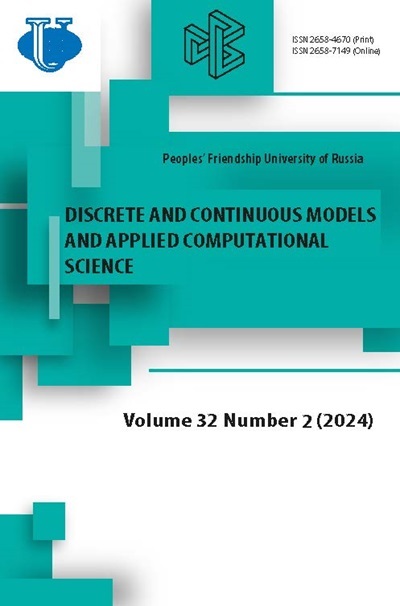О свойствах численных решений динамических систем, полученных по схеме средней точки
- Авторы: Гердт В.П.1, Малых М.Д.2, Севастьянов Л.А.1,2, Ин Ю.2,3
-
Учреждения:
- Объединенный институт ядерных исследований
- Российский университет дружбы народов
- Университет Каили
- Выпуск: Том 27, № 3 (2019)
- Страницы: 242-262
- Раздел: Численное и имитационное моделирование
- URL: https://journals.rudn.ru/miph/article/view/22703
- DOI: https://doi.org/10.22363/2658-4670-2019-27-3-242-262
Цитировать
Полный текст
Аннотация
В статье рассматривается схема средней точки как разностная схема для динамической системы вида ̇ = (). Эта схема замечательна тем, что в силу теоремы Купера сохраняет все квадратичные интегралы движения, более того, это - простейшая схема из числа симплектических схем Рунге-Кутты, обладающих названным свойством. Свойства приближённых решений изучены в рамках численных экспериментов с линейным и нелинейным осцилляторами, а также с системой нескольких связанных осцилляторов. Показано, что помимо сохранения всех интегралов движения, приближённые решения наследуют периодичность движения. При этом уделено внимание обсуждению введения понятие периодичности приближённого решения, найденного по разностной схеме. В случае нелинейного осциллятора выполнение каждого шага требует решения системы нелинейных алгебраических уравнений. Обсуждены вопросы организации вычислений по таким схемам. Дано сравнение с другими схемами, в том числе симметрическими относительно перестановки и .̂
Ключевые слова
Об авторах
В. П. Гердт
Объединенный институт ядерных исследований
Автор, ответственный за переписку.
Email: gerdt@jinr.ru
Doctor of Physical and Mathematical Sciences, Full Professor at the Joint Institute for Nuclear Research (JINR) where he is the head of the Group of Algebraic and Quantum Computations
ул. Жолио Кюри, д. 6, г. Дубна, Московская область, 141980, РоссияМ. Д. Малых
Российский университет дружбы народов
Email: malykh-md@rudn.ru
Candidate of Physical and Mathematical Sciences, assistant professor of Department of Applied Probability and Informatics of Peoples’ Friendship University of Russia
ул. Миклухо-Маклая, д. 6, г. Москва, 117198, РоссияЛ. А. Севастьянов
Объединенный институт ядерных исследований; Российский университет дружбы народов
Email: sevastianov-la@rudn.ru
professor, Doctor of Physical and Mathematical Sciences, professor of Department of Applied Probability and Informatics of Peoples’ Friendship University of Russia (RUDN University)
ул. Жолио Кюри, д. 6, г. Дубна, Московская область, 141980, Россия; ул. Миклухо-Маклая, д. 6, г. Москва, 117198, РоссияЮй Ин
Российский университет дружбы народов; Университет Каили
Email: yingy6165@gmail.com
postgraduate student of Department of Applied Probability and Informatics of Peoples’ Friendship University of Russia (RUDN University); assistant professor of Department of Algebra and Geometry, Kaili University
ул. Миклухо-Маклая, д. 6, г. Москва, 117198, Россия; Kaiyuan Road 3, Каили 556011, КитайСписок литературы
- A. Goriely, Integrability and nonintegrability of dynamical systems. Singapore; River Edge, NJ: World Scientific, 2001.
- E. Hairer, G. Wanner, and C. Lubich, Geometric numerical integration. Structure-preserving algorithms for ordinary differential equations. Berlin Heidelberg New York: Springer, 2000.
- L. Königsberger, Die Principien der Mechanik. Leipzig: Teubner, 1901.
- Y. B. Suris, “Hamiltonian methods of Runge-Kutta type and their variational interpretation [Gamil’tonovy metody tipa Runge-Kutty i ikh variatsionnaya traktovka],” Matematicheskoye modelirovaniye, vol. 2, no. 4, pp. 78-87, 1990, in Russian.
- G. J. Cooper, “Stability of Runge-Kutta methods for trajectory problems,” IMA Journal of Numerical Analysis, vol. 7, pp. 1-13, 1987. doi: 10.1093/imanum/7.1.1.
- J. M. Sanz-Serna, “Symplectic Runge-Kutta schemes for adjoint equations, automatic differentiation, optimal control, and more,” SIAM REVIEW, vol. 58, pp. 3-33, 1 2016. doi: 10.1137/151002769.
- P. Painlevé, “Mémore sur les intégrales du problème des corps,” in Œuvres de Paul Painlevé. 1975.
- V. V. Golubev, Vorlesungen über Differentialgleichungen im Komplexen. Leipzig: VEB Deutscher Verlag der Wissenschaften, 1958.
- P. F. Byrd and M. D. Friedman, Handbook of elliptic integrals for engineers and scientists. Springer, 1971. DOI: 10. 1007 / 978 3 642 65138-0.
- W. A. Stein. (2015). Sage Mathematics Software (Version 6.7), The Sage Development Team, [Online]. Available: http://www.sagemath.org.
- D. A. Cox, J. Little, and D. O’Shea, Ideals, varieties, and algorithms: an introduction to computational algebraic geometry and commutative algebra, 4th ed. Springer, 2015. doi: 10.1007/978-3-319-16721-3.
- Numerical Recipes: The Art of Scientific Computing, 3rd ed. Cambridge University Press, 2007, 1256 pp.
- E. A. Ayryan, M. D. Malykh, L. A. Sevastianov, and Yu Ying, “Finite difference schemes and classical transcendental functions,” LNCS, vol. 11189, pp. 3-33, 2019. doi: 10.1007/978-3-030-10692-8_26.
- E. A. Ayryan, M. D. Malykh, L. A. Sevastianov, and Yu Ying, “On explicit difference schemes for autonomous systems of differential equations on manifolds,” LNCS, vol. 11661, pp. 343-361, 2019. doi: 10.1007/9783-030-26831-2_23.
- R. Kozlov, “Conservative discretizations of the Kepler motion,” Journal of Physics A, vol. 40, no. 17, pp. 4529-4539, 2007. doi: 10.1088/17518113/40/17/009.
- Y. A. Blinkov and V. P. Gerdt, “On computer algebra aided numerical solution of ODE by finite difference method,” in Polynomial Computer Algebra ’2019. April 15-20, 2019. Euler International Mathematical Institute, St. Petersburg, RUSSIA. 2019.
















